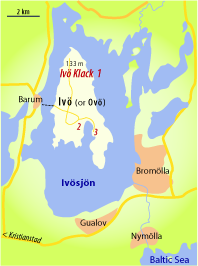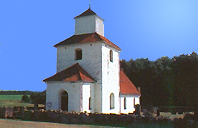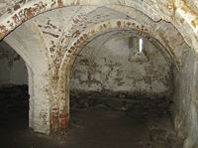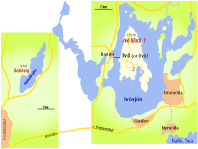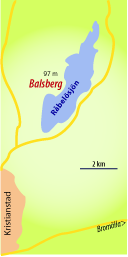|
Ivö (ou Ovö) is an island located on the Lake Ivö, the largest one in Scania (SE Sweden).
Historically the province of Scania was a part of Terra Scania (Skåneland in Swedish and Skånelandene in Danish), which together with Jutland and Zealand, the other two Lands of Denmark, formed a Danish state in the 9th century. Scania is separated from both regions by the strait of Sund (Öresund in Swedish, Øresund in Danish).
Following the Treaty of Roskilde in 1658, Scania became a possession of the Swedish Crown.
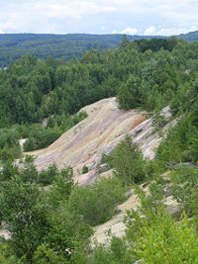 1 - On the promontory at Ivö Klack, on the northern tip of the island of Ivö, are the remains of china-clay (kaolin) mines worked from the end of the nineteenth century until well into the 1950s. The clay used to be transported by barge across the lake to the Iföverken sanitaryware factory in Bromölla. From these quarries many fossils were collected, especially the brachiopod craniid Crania craniolaris Linnaeus, 1758, as well as another craniid Isocrania egnabergensis (Retzius, 1781) has been recorded here too. Both brachiopod species occur in other outcrops in south of Sweden, i.e., in Balsberg (see below), in Ignaberga near Hässleholms. 1 - On the promontory at Ivö Klack, on the northern tip of the island of Ivö, are the remains of china-clay (kaolin) mines worked from the end of the nineteenth century until well into the 1950s. The clay used to be transported by barge across the lake to the Iföverken sanitaryware factory in Bromölla. From these quarries many fossils were collected, especially the brachiopod craniid Crania craniolaris Linnaeus, 1758, as well as another craniid Isocrania egnabergensis (Retzius, 1781) has been recorded here too. Both brachiopod species occur in other outcrops in south of Sweden, i.e., in Balsberg (see below), in Ignaberga near Hässleholms.
[1]
2 - A medieval church that was probably built by Archbishop Sunesen. The church was dedicated to Saint Ursula during the Catholic period and a spring down below the steep river bank is still called Ursula´s Spring.
In the same location the ruins of Ivöhus are situated. Ivöhus was a castle built also by Sunesen. All that remains of the once magnificent castle are the ruins of the ground floor.
Anders Sunesen (also Andreas, Suneson, Sunesøn, Latin: Andreas Sunonis), ca 1167 – 1228, was a famous Danish archbishop of Lund. He lived his last years on Ivö Island in Ivösjön (Ivö Lake). It has been speculated that his death in 1228 may have been attributed to leprosy. He is buried in a sarcophagus in Lund Cathedral.
3 - The Archbishop´s cellar is located at Hovgården, 2 km southeast of the Ivö Church [2].
See other links to Ivö, to Ivö Lake, to A. Sunesen
|
|
The cave of Balsberg is located in Cretaceous karstic system at about 9 km north of Kristianstad, in the western bank of Lake Ravalov (Råbelöv) and at 11 km in the W of Ivö - see Maps. This cave, well- known by speologists, has been visited on 23th May 1749 by Carl von Linné, where he has collected fossils, like the brachiopods he described as Anomia craniolaris in 1758 (see systematics).
|
